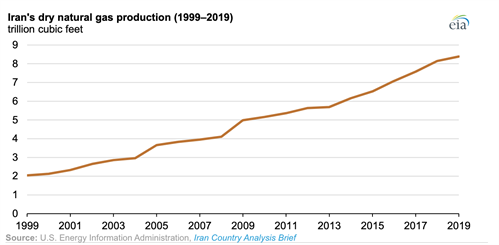Despite sanctions, Iran's dry natural gas production grew steadily over the past 20 years

Despite international sanctions, Iran produced 8.4 trillion cubic feet (Tcf) of dry natural gas in 2019, making the country the world’s third-largest dry natural gas producer after the United States and Russia. Natural gas production in Iran has grown steadily over the past two decades despite sanctions that affected Iran’s energy exports, financial transactions, and imports of certain technologies. Iran’s domestic natural gas demand, which the sanctions do not affect, has been the main driver of Iran’s natural gas production growth.
Since 2018, when the United States government withdrew from the Joint Comprehensive Plan of Action (JCPOA) and reinstated sanctions on Iran’s oil exports, Iran’s natural gas production growth has slowed. Although energy-sector sanctions mostly affected Iran’s production and exports of crude oil and liquid fuels, these sanctions also limited natural gas production and exports. Production growth slowed down because Iran could not export condensate, which is co-produced with natural gas.
The reinstatement of crude oil sanctions on Iran also affected agreements with foreign companies on natural gas field development projects and delayed the Iranian government’s long-standing plans to build the infrastructure to export liquefied natural gas. Because Iran has not been able to acquire the technology necessary for natural gas liquefaction because of sanctions, these plans have not moved forward.
Much of the growth in natural gas production comes from development of the offshore South Pars field in the Persian Gulf, which was discovered in 1990. Natural gas production at South Pars began in 2003, and so far, 23 of the 24 development phases have started producing, although not all of them have reached maximum capacity. At maximum capacity, the South Pars natural gas field could annually produce 9.49 Tcf of natural gas.
Iran has some of the world’s largest deposits of proved natural gas reserves, and it held the second-most reserves of natural gas in 2020 following Russia. Almost all of the natural gas that Iran produced in 2019 was consumed domestically, and in 2019, Iran consumed more natural gas than all but three other countries: the United States, Russia, and China.
In Iran, the residential and commercial sectors use natural gas for space heating, and the industrial sector uses it for feedstock, especially in the petrochemicals industry. Iran also trades relatively small volumes of natural gas regionally through pipelines. Since 2017, when Iran began exporting to Iraq, Iran’s natural gas exports have risen substantially. In 2019, Iran exported natural gas to Turkey, Armenia, Azerbaijan, and Iraq. Iran also imported natural gas from Azerbaijan.
Principal contributors: Kimberly Peterson, Jonathan Russo

- ExxonMobil halts 1-Bft3d blue hydrogen project in Texas
- Aramco and Yokogawa commission multiple autonomous control AI agents at Fadhili gas plant
- Ukraine will resume gas imports via Transbalkan route in November
- Mitsubishi to inject $260 MM into Brunei LNG project
- Freeport LNG (U.S.) on track to take in more natgas on Thursday after unit outage



Comments